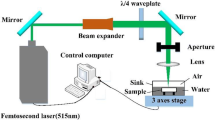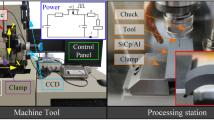Abstract
Controlling precisely the depth in glass micro-drilling by spark assisted chemical engraving (SACE) remains challenging, particularly for low depths. The possibility of using an electrically conductive material as an etch-stop layer for SACE gravity-feed drilling is investigated in this paper. Micromachining with constant DC and pulsed DC of 30–35 μm thick SiO2 deposited on low resistive silicon substrate demonstrated the etch-stop function of the conductive silicon. Measurements of etch rates and hole profiles along with scanning electron microscope imaging revealed the mechanism underlying the etch-stop process. Low resistive silicon is demonstrated to be a good etch-stop layer for SACE gravity-feed drilling. Demonstration of machining of SiO2 layer on silicon as a substrate and an etch-stop layer opens up new possibilities to adapt SACE for developing devices on silicon platform.









Similar content being viewed by others
References
Akimoto T, Nanbu H, Ikawa E (1995) Reactive ion etching lag on high rate oxide etching using high density plasma. J Vac Sci Technol B13:2390–2393
Allagui A and Wüthrich R (2009) Gas film formation time and gas film life time during electrochemical discharge phenomenon. Electrochimica Acta 54:5336–5343
Daridon A, Fascio V, Lichtenberg J, Wüthrich R, Langen H, Verpoorte E, De Rooij NF (2001) Multilayer microfluidic glass chips for microanalytical applications. Fresenius J Anal Chem 371:261–269
Donohue LA, Hopkins J, Barnett R, Newton A, Barker A (2004) Developments in Si and SiO2 etching for MEMS-based optical applications. Proc SPIE 5347:44–53
Fascio V, Langen HH, Bleuler H, Comninellis Ch (2003) Investigations of the spark assisted chemical engraving. Electrochem Commun 5:203–207
Fascio V, Wüthrich R, Bleuler H (2004) Spark assisted chemical engraving in the light of electrochemistry. Electrochim Acta 49:3997–4003
Gautam N, Jain VK (1998) Experimental investigations into ECSD process using various tool kinematics Int. J Mach Tools Manuf 38:15–27
Jain VK, Chak SK (2000) Electrochemical spark trepanning of alumina and quartz. Machining Sci Technol 4:277–290
Jalali M, Maillard P, Wüthrich R (2009) Towards a better understanding of glass gravity-feed micro-hole drilling with electrochemical discharges. J Micromech Microeng 19:045001 (7pp)
Kim DJ, Ahn Y, Lee SH, Kim YK (2006) Voltage pulse frequency and duty ratio effects in an electrochemical discharge microdrilling process of Pyrex glass. Int J Mach Tools Manuf 46:1064–1067
Kurafuji H, Suda K (1968) Electrical discharge drilling of glass. Annals CIRP 16:415–419
Langen H, Breguet JM, Bleuler H, Renaud Ph, Masuzawa T (1998) Micro electrochemical discharge machining of glass. Int J Elect Machining 3:65–69
Lee ES, Howard D, Liang E, Collins SD, Smith RL (2004) Removable tubing interconnects for glass based micro-fluidic systems made using ECDM. J Micromech Microeng 14:535–541
Lim HJ, Lim YM, Kim SH, Kwak YK (2001) Self-aligned micro tool and electrochemical discharge machining (ECDM) for ceramic materials. Proc SPIE 4416:348–353
Tokura H, Kondoh I, Yoshikswa M (1989) Ceramic material processing by electrical discharge in electrolyte. J Mater Sci 24:991–998
Wüthrich R (2009) Micromachining using electrochemical discharge phenomenon: fundamentals and application of spark assisted chemical engraving, William Andrew ISBN: 0815515871
Wuthrich R, Fascio V (2005) Machining of non-conducting materials using electrochemical discharge phenomenon—an overview. Int J Mach Tools Manuf 45:1095–1108
Wüthrich R, Hof LA (2006) The gas film in Spark Assisted Chemical Engraving (SACE): a key element for micro-machining applications. Int J Mach Tools Manuf 46:828–835
Wüthrich R, Comninellis Ch, Bleuler H (2005) Bubble evolution on vertical electrodes under extreme current densities. Electrochim Acta 50:5242–5246
Wüthrich R, Spaelter U, Wu Y, Bleuler H (2006a) A systematic characterization method for gravity-feed micro-hole drilling in glass with spark assisted chemical engraving (SACE). J Micromech Microeng 16:1891–1896
Wüthrich R, Spaelter U, Bleuler H (2006b) The current signal in spark-assisted chemical engraving (SACE): what does it tell us? J Micromech Microeng 16:779–785
Yang CT, Ho SS, Yan BH (2001) Micro hole machining of borosilicate glass trough electrochemical discharge machining (ECDM) Key Eng Mat. 196:149–166
Zheng Z-P, Lin J-K, Huang F-Y, Yan B-H (2008) Improving the machining efficiency in electrochemical discharge machining (ECDM) microhole drilling by offset pulse voltage. J Micromech Microeng 18:025014 (6 pp)
Acknowledgments
This work was supported by the Canadian Institute for Photonics Innovations (CIPI) and the Natural Sciences and Engineering Research Council of Canada (NSERC). The authors acknowledge the technical support provided by Enablence Inc. Ottawa, Canada.
Author information
Authors and Affiliations
Corresponding author
Rights and permissions
About this article
Cite this article
Ozhikandathil, J., Morrison, A., Packirisamy, M. et al. Low resistive silicon substrate as an etch-stop layer for drilling thick SiO2 by spark assisted chemical engraving (SACE). Microsyst Technol 17, 373–380 (2011). https://doi.org/10.1007/s00542-011-1248-4
Received:
Accepted:
Published:
Issue Date:
DOI: https://doi.org/10.1007/s00542-011-1248-4




